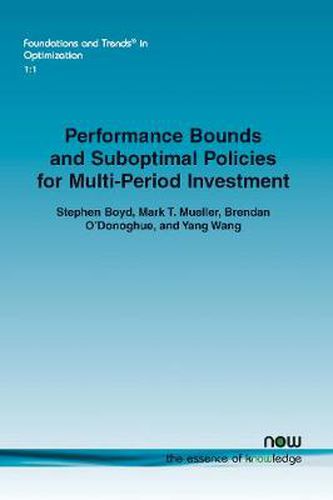Readings Newsletter
Become a Readings Member to make your shopping experience even easier.
Sign in or sign up for free!
You’re not far away from qualifying for FREE standard shipping within Australia
You’ve qualified for FREE standard shipping within Australia
The cart is loading…






This title is printed to order. This book may have been self-published. If so, we cannot guarantee the quality of the content. In the main most books will have gone through the editing process however some may not. We therefore suggest that you be aware of this before ordering this book. If in doubt check either the author or publisher’s details as we are unable to accept any returns unless they are faulty. Please contact us if you have any questions.
Examines dynamic trading of a portfolio of assets in discrete periods over a finite time horizon, with arbitrary time-varying distribution of asset returns. The goal is to maximize the total expected revenue from the portfolio, while respecting constraints on the portfolio like a required terminal portfolio and leverage and risk limits. The revenue takes into account the gross cash generated in trades, transaction costs, and costs associated with the positions, such as fees for holding short positions.
The model that is presented takes the form of a stochastic control problem with linear dynamics and convex cost function and constraints. While this problem can be tractably solved in several special cases - for example, when all costs are convex quadratic, or when there are no transaction costs - the focus is on the more general case, with nonquadratic cost terms and transaction costs.
Performance Bounds and Suboptimal Policies for Multi-Period Investment shows how to use linear matrix inequality techniques and semidefinite programming to produce a quadratic bound on the value function, which in turn gives a bound on the optimal performance. This performance bound can be used to judge the performance obtained by any suboptimal policy.
As a by-product of the performance bound computation, an approximate dynamic programming policy is obtained that requires the solution of a convex optimization problem, often a quadratic program, to determine the trades to carry out in each step.
$9.00 standard shipping within Australia
FREE standard shipping within Australia for orders over $100.00
Express & International shipping calculated at checkout
This title is printed to order. This book may have been self-published. If so, we cannot guarantee the quality of the content. In the main most books will have gone through the editing process however some may not. We therefore suggest that you be aware of this before ordering this book. If in doubt check either the author or publisher’s details as we are unable to accept any returns unless they are faulty. Please contact us if you have any questions.
Examines dynamic trading of a portfolio of assets in discrete periods over a finite time horizon, with arbitrary time-varying distribution of asset returns. The goal is to maximize the total expected revenue from the portfolio, while respecting constraints on the portfolio like a required terminal portfolio and leverage and risk limits. The revenue takes into account the gross cash generated in trades, transaction costs, and costs associated with the positions, such as fees for holding short positions.
The model that is presented takes the form of a stochastic control problem with linear dynamics and convex cost function and constraints. While this problem can be tractably solved in several special cases - for example, when all costs are convex quadratic, or when there are no transaction costs - the focus is on the more general case, with nonquadratic cost terms and transaction costs.
Performance Bounds and Suboptimal Policies for Multi-Period Investment shows how to use linear matrix inequality techniques and semidefinite programming to produce a quadratic bound on the value function, which in turn gives a bound on the optimal performance. This performance bound can be used to judge the performance obtained by any suboptimal policy.
As a by-product of the performance bound computation, an approximate dynamic programming policy is obtained that requires the solution of a convex optimization problem, often a quadratic program, to determine the trades to carry out in each step.